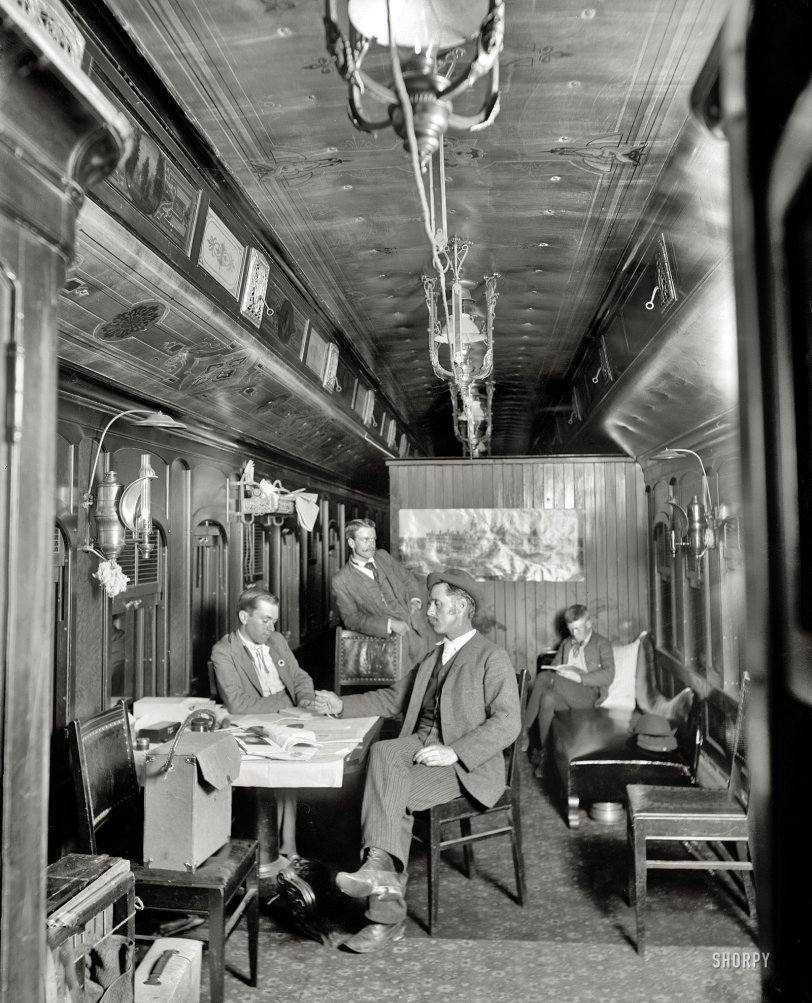


Framed or unframed, desk size to sofa size, printed by us in Arizona and Alabama since 2007. Explore now.
Shorpy is funded by you. Patreon contributors get an ad-free experience.
Learn more.

- Baldwin 62303
- Baldwin VO-1000
- Cold
- No expense spared
- Tough Guys
- Lost in Toyland
- And without gloves
- If I were a blindfolded time traveler
- Smoke Consumer Also Cooks
- Oh that stove!
- Possibly still there?
- What?!?
- $100 Reward
- Freeze Frame
- Texas Flyer wanted
- Just a Year Too Soon
- WWII -- Replacing men with women at the railroad crossing.
- Yes, Icing
- You kids drive me nuts!
- NOT An Easy Job
- I wonder
- Just add window boxes
- Icing Platform?
- Indiana Harbor Belt abides
- Freezing haze
- Corrections (for those who care)
- C&NW at Nelson
- Fallen Flags
- A dangerous job made worse
- Water Stop
Print Emporium
New York Central: 1900

Circa 1900. "New York Central R.R. photographic car." Possibly one of the "specials" reserved by DPC for the use of its photographers as they traveled around the Northeast. Detroit Photographic Co. glass negative. View full size.
Just a guess
So, that wooden structure in the middle of the car must be a darkroom? Or a port-a-potty.
Socks, but not the Socks the cat.
In early twentieth-century America it was common to find young boys wearing "over the knee" socks with their short pants. I think the trend even lasted longer in Europe.
That cord under the lamps
Is a communicating cord. In pre-radio days (actually, well into the Amtrak era), this was a way for the conductor to communicate with the engineer. You can tell if a passenger car is equipped with it if it has a second, slightly smaller air hose alongside the brake system hose.
It operated on a reverse-air principle, that is, when you pulled it, it opened a valve on the car and let air out of the line (you could hear it hiss), and caused a shrill little whistle that sounded much like a boatswain's whistle to sound in the engine cab.
Many people think this cord is the emergency brake, but it's not. Railroads would never make the emergency brake so readily accessible. Doing so would cause too many "false" emergency applications when it was erroneously pulled by passengers. The emergency brake was always located on the bulkhead wall just inside the end doors of a car.
In the modern era, the communicating cord was only available in the vestibules (the enclosure at the end of the car with steps), usually as a small overhead chain. In the first generation of new Amtrak cars, the system was electrified, and the conductor used it to signal by pressing a button.
Cat? I can't find a cat, but
looking for one made me notice something else. Is that kid wearing panty hose?
About those lamps, if they are oil, kerosene is pretty safe. It's not volatile, like gasoline or other lighter fuels. It needs a wick (or something to spread out on, wood will work) so it can mix with air to burn. It will vaporize, but you have to spray it or heat it to get it to. You could take a bucket of kerosene and drop matches in it, and, unless they floated and acted as a wick, they'd just go out.
Gas or Oil at Night?
Julius Pintsch's gas compressed from distilled naphtha was common in railroad cars before fire and other fears led to the use of electric lights.
The thirsty railroad cat said
Yuck! Would it have been too much trouble for one of you posers to tell me this is a spittoon?
The Light at Night
Does anybody know if those are oil or gas lamps in the car? Seems either would be dangerous but they don't look like they're electric.
Dapper dan
The dude standing must be a bulk purchaser of moustache wax.
Squeeze Bulb
I'm sure others have noticed the man, center at the table, making an effort to look nonchalant. The deflated pneumatic squeeze bulb in his hand tells us it is a posed photo and he is keeping the shutter open. The air pushed through the tube, causes a piston to push a pin into the shutter and hold it open. If you have ever noticed a "B" for bulb on a camera, that is how the setting came to be named. Useful for those times that the shutter needed to be open for longer than normal, such as low light rooms, night-time fireworks, etc.
























On Shorpy:
Today’s Top 5